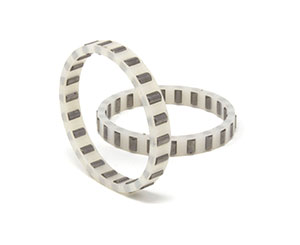FAQ – Precision Pins

Q: What is the definition of each product, and the difference between them?
A: Pins, rollers, dowels, needle rollers, and shafts are all mechanical parts that are cylindrical in shape. Although these products are different, the names are sometimes used interchangeably.
Hartford Technologies manufactures all of these, as parts or assemblies, in steel, stainless steel and other materials.
A “pin” is a mechanical fastener that joins other parts together in an assembly. A pin may act as a pivot, hinge, jig, fixture or shaft. A jig is typically used to hold a work-piece in place and/or guide a tool operating on the device. A pin is often used to locate or hold parts. Some pins are headed; others are not.
“Roller” implies that the part moves (rolls) when in use. Generally a roller acts as a bearing, supporting a load along its outer diameter.
“Dowel” is often used in conjunction with “pin” and can be used as a detent or to closely align or support parts. A detent prevents or resists movement until it is released.
“Needle” or “needle roller” implies that the length is significantly longer than the diameter. The part is acting as a rolling element.
“Shaft” describes the long narrow portion of a complex cylindrical component or cylindrical part that has been turned or machined. Some customers use the term shaft to describe even basic parts that most people would label as pins or rollers.
Hartford Technologies produces pins, rollers, dowels, needle rollers and shafts in many configurations. We specialize in precision and custom parts as opposed to commercial off-the-shelf parts.
Q: What are the most common materials used for pins, rollers, dowels and needle rollers?
A: Bearing grade chrome steel is frequently used for pins and rollers due to its superior wear properties, high hardness (typically Rockwell C 60 to 65) and strength. This steel is known as 52100 (US), 100Cr6 (Europe), SUJ2 (Japan) and GCr15 (China), all of which are essentially identical.
Stainless steel is used for improved corrosion protection. Martensitic 400 series stainless steel (most commonly 440) can also be heat treated to achieve high hardness levels. Austenitic 300 series stainless steel (e.g. 302, 304, 316, etc.) offers better corrosion resistance, but must be supplied (and therefore processed) in a harder condition (if hardness is required), as it cannot be heat treated; hardness can only be increased through cold working.
Other common materials for pins and rollers include low carbon steel, which is typically case-hardened, and high carbon steel, which is normally through-hardened. Precision pins and custom rollers are also made from other alloy steels (e.g. 4140, 4340, 8620, etc.) and specialty stainless steels (e.g. precipitation hardening stainless steel, such as 17-4PH, etc.).
Q: How are pins and rollers produced?
A: For bearing grade chrome steel parts, the raw material for pins, rollers, dowels and needle rollers is typically supplied in coil wire form. Parts are cut to approximate length. If the steel pin or roller only requires a small end radius or break edge, the parts may be tumbled in a large barrel to produce this condition.
This batch processing is very efficient. If the final configuration of the steel pin or roller has a large end radius or chamfer, that feature may be added in its basic form during the cutting process. In most cases, the end radius or chamfer of the steel pin or roller is added as a separate step.
A centerless grinding process is performed to bring the part close to its final diameter. The parts are then heat treated, typically followed by a quench and temper process. Depending on the required tolerances for diameter and length, one or more end grinding and centerless grinding operations are performed to produce the steel pin or roller to the required precision. Often, tumbling (deburring) and polishing complete the process.
Numerous tests are used along the manufacturing flow to verify quality in dimensions and workmanship. Pins and rollers are typically required to meet high degrees of precision in dimension and form.
For some customers and applications, extraordinary quality assurance is required. Hartford Technologies has high speed sorting machines that perform 100% inspection for diameter and/or length. We also have camera-based vision systems that perform 100% inspection for visual defects such as scratches, pits or discoloration.
Q: What are some of the specifications for pins and rollers?
A: Some of the more common industry specifications for steel pins and rollers are listed below:
- ASME B18.8.2 dowel pins
- ASTM F2443 needle rollers, spherical ends
- ASTM F2511 needle bearing rollers
- DIN 5402 part 1 cylindrical rollers (parts of roller bearings)
- DIN 5402 part 3 rollers for needle roller bearings
- DIN 6325 dowel pins
- ISO 2338 parallel pins
- ISO 8734 dowel pins
Q: What are the common end configurations for pins and rollers?
A: The design of the two ends of a steel pin or roller is normally selected after consideration of its function and how and where it is assembled. If there are no assembly concerns, the most economical configuration is a small end radius. This feature can be added during a simple batch process barrel tumbling step.
A larger end radius or chamfer is often chosen for the steel pin or roller if it is assembled into a hole with little clearance or interference conditions. In that case, a separate machining process is needed. In some parts, the part ends perform a function (e.g. cam or pivot), so a more specific geometry (e.g. spherical ended pin) is required. Again, a separate turning process is added to create this feature.
Q: Do all pins and rollers have a straight (constant diameter) OD?
A: Although most steel pins and rollers are defined by a (constant) outside diameter with high precision (diameter tolerance ± 0.0001 inch / ± 0.0025 mm), parts that are used as rolling elements in bearings are sometimes designed with a crowned diameter. For a crowned OD, a precision (constant) diameter is required along the center section of the length of the steel roller, but a diameter drop (taper) is specified for each end. This design prevents higher stresses from occurring at the ends of the steel roller during its operation as a rolling bearing element. Typically, multiple grinding or superfinishing processes are used to achieve a crowned profile for a steel roller.






